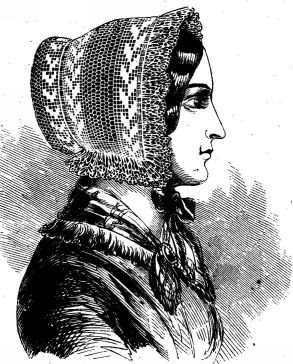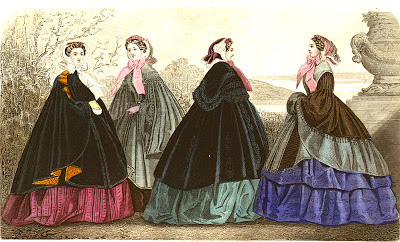 |
| A lacy black 'neckerchief' from Beeton's Book of Needlework, 1870. |
 |
| A crocheted nightcap from The Ladies' Work-Book. |
 |
| A crocheted doily from The Ladies' Work-Book. |
Yup, I was fooled by the black-and-white illustrations. As it turns out, many if not most of the old patterns call for coloured yarn or thread. For example, Isabella Beeton's 'Knitted Shawl' pattern specifies "Shetland wool, white and scarlet"; and Cornelia Mee's 'Open Diamond Pattern for the Centre of a Shawl' "looks extremely well in stripes of scarlet and white".
I decided to check my new vision of colourful 19thC crafting by sampling three readily-accessible books from that time: Beeton's Book of Needlework (1870) by Isabella Beeton, Exercises in Knitting (1846) by Cornelia Mee, and My Knitting Book (1843) by Miss Lambert. (Follow the links for the full text.)
Where a colour of yarn is specified, there is a wide range of colour schemes:
- Black, e.g. Beeton's kerchief in the first illustration above, Mee's 'Leaf Pattern for Half-Square Shawl';
- White, e.g. Mee's 'Beautiful Pattern for a Shetland Shawl';
- Several shades of one colour, e.g. Mee's 'Beautiful Coral Pattern' for a chair-cover in sixteen shades of scarlet, and her 'Rose-Leaf Pattern' in fifteen shades of blue;
- Two contrasting colours, e.g. Lambert's 'Star Pattern Shawl' in claret and blue, Beeton's 'Tobacco Pouch' in black and crimson;
- Red/scarlet/claret/rose and white, e.g. Beeton's 'Crochet Brioche Cushion' in white plus six shades of red, Lambert's 'Very Pretty Cuffs' in red and white, and her 'Warm Half-Square Shawl' in rose and white;
- Many colours, e.g. Mee's 'German Pattern' in claret, gold, blue, white, and scarlet; and her 'Brioche Cushion' in scarlet, white, blue, gold, lilac, and green;
- Pink for baby items, e.g. Lambert's 'Baby's Hood' and 'Baby's Sock' (the pink/blue divide is more recent).
It's a shame that these books have no colour illustrations (and not very many black and white ones). Beeton's more famous book, Beeton's Book of Household Management (1861), did have colour illustrations. I have a poster of this one on my wall, for dessert inspiration:
To see the colours people wore, we need to turn to artworks, surviving garments and accessories, and fashion illustrations from the time. Here is a hand-tinted 'fashion plate' with fabulous colourful gowns:
 |
| From Godey's Lady's Book, November 1859 |
(If you're interested in historical clothing, I recommend checking out The Dreamstress' blog. This edition of her regular 'Rate the dress' feature is particularly colourful: Extremely red in 1865.)
For examples of surviving Victorian knitting and crochet, a good resource is the V&A Museum's online collection - just search for 'knitting' or 'crochet'. I found this lovely little knitted purse which looks a bit like a pineapple:
In case you're wondering, many of the patterns in nineteenth-century needlework books are quite easy for modern crafters to follow. Some have errors, and others are just plain tricky, but I've successfully followed the instructions for some of the knitting-stitch patterns in the books listed above. There are some beautiful crocheted lace pattern's in Beeton's book, too. I'm going to experiment with this one:
It should help me resist the urge to make eye-searingly-colourful lacy doilies...
...Maybe.




You can read Franklin Habit's take on the many problems with "Beeton's" Book of Needlework here:
ReplyDeletehttp://www.knitty.com/ISSUEss13/FEATss13SIT.php